Accounting Theory & Contemporary Issues: ACC301 Assignment
VerifiedAdded on 2022/12/23
|5
|1118
|52
Homework Assignment
AI Summary
This assignment analyzes the revised (2018) conceptual framework for financial reporting, focusing on four key questions. The first question explores the role and advantages of the conceptual framework, highlighting its importance in guiding the development and application of IFRS standards, along with the criticism regarding the measurement of assets and liabilities. The second question discusses the purpose and importance of financial reporting, emphasizing its role in providing information for stakeholders to make informed decisions. The third question examines the concept of prudence, its implications, and its role in ensuring conservative accounting practices. The final question delves into the concept of substance over form and faithful representation, explaining how accounting transactions should reflect the economic reality rather than the legal form. The assignment includes a video presentation summarizing the findings, adhering to the guidelines provided, and offering insights into the practical application of accounting principles.
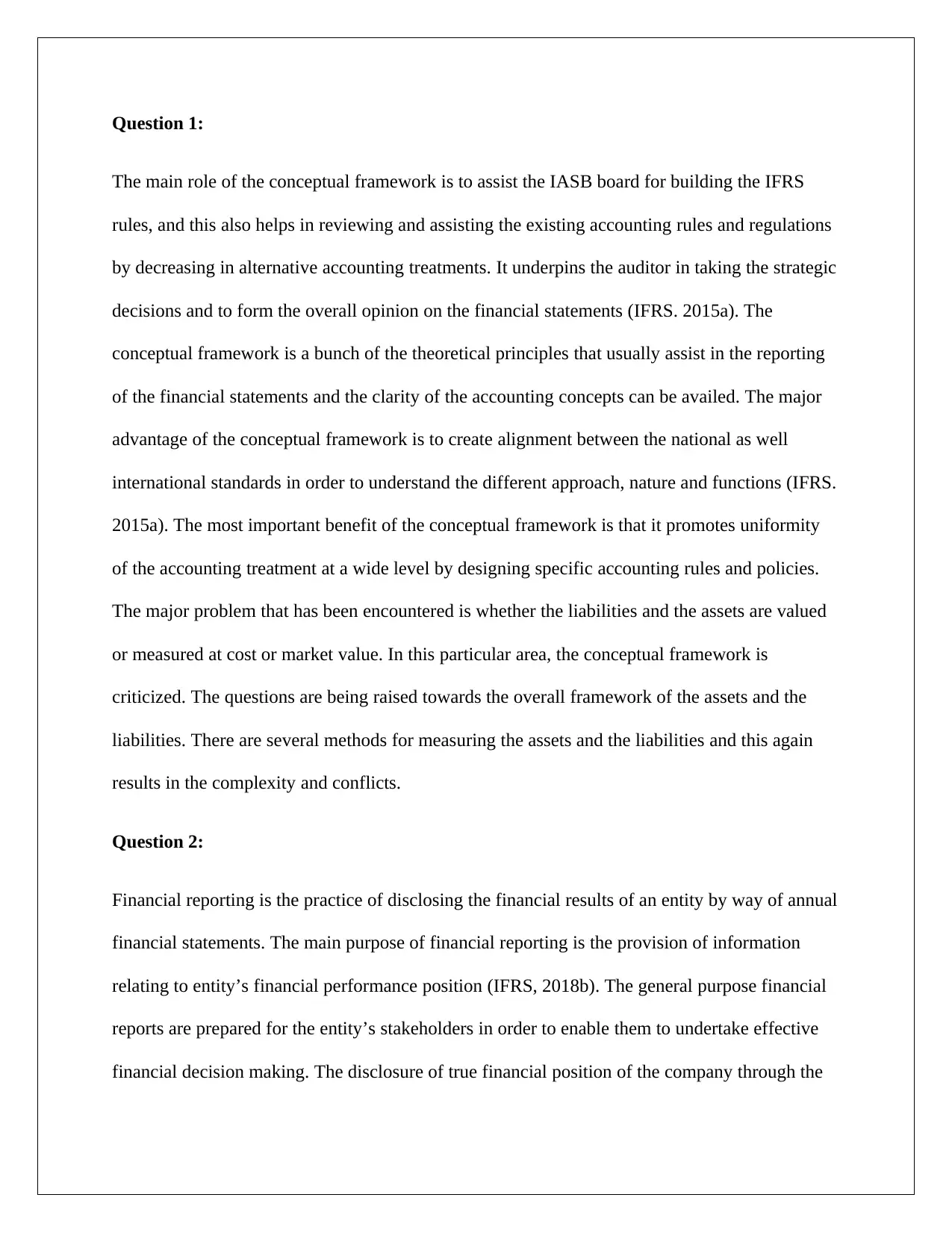
Question 1:
The main role of the conceptual framework is to assist the IASB board for building the IFRS
rules, and this also helps in reviewing and assisting the existing accounting rules and regulations
by decreasing in alternative accounting treatments. It underpins the auditor in taking the strategic
decisions and to form the overall opinion on the financial statements (IFRS. 2015a). The
conceptual framework is a bunch of the theoretical principles that usually assist in the reporting
of the financial statements and the clarity of the accounting concepts can be availed. The major
advantage of the conceptual framework is to create alignment between the national as well
international standards in order to understand the different approach, nature and functions (IFRS.
2015a). The most important benefit of the conceptual framework is that it promotes uniformity
of the accounting treatment at a wide level by designing specific accounting rules and policies.
The major problem that has been encountered is whether the liabilities and the assets are valued
or measured at cost or market value. In this particular area, the conceptual framework is
criticized. The questions are being raised towards the overall framework of the assets and the
liabilities. There are several methods for measuring the assets and the liabilities and this again
results in the complexity and conflicts.
Question 2:
Financial reporting is the practice of disclosing the financial results of an entity by way of annual
financial statements. The main purpose of financial reporting is the provision of information
relating to entity’s financial performance position (IFRS, 2018b). The general purpose financial
reports are prepared for the entity’s stakeholders in order to enable them to undertake effective
financial decision making. The disclosure of true financial position of the company through the
The main role of the conceptual framework is to assist the IASB board for building the IFRS
rules, and this also helps in reviewing and assisting the existing accounting rules and regulations
by decreasing in alternative accounting treatments. It underpins the auditor in taking the strategic
decisions and to form the overall opinion on the financial statements (IFRS. 2015a). The
conceptual framework is a bunch of the theoretical principles that usually assist in the reporting
of the financial statements and the clarity of the accounting concepts can be availed. The major
advantage of the conceptual framework is to create alignment between the national as well
international standards in order to understand the different approach, nature and functions (IFRS.
2015a). The most important benefit of the conceptual framework is that it promotes uniformity
of the accounting treatment at a wide level by designing specific accounting rules and policies.
The major problem that has been encountered is whether the liabilities and the assets are valued
or measured at cost or market value. In this particular area, the conceptual framework is
criticized. The questions are being raised towards the overall framework of the assets and the
liabilities. There are several methods for measuring the assets and the liabilities and this again
results in the complexity and conflicts.
Question 2:
Financial reporting is the practice of disclosing the financial results of an entity by way of annual
financial statements. The main purpose of financial reporting is the provision of information
relating to entity’s financial performance position (IFRS, 2018b). The general purpose financial
reports are prepared for the entity’s stakeholders in order to enable them to undertake effective
financial decision making. The disclosure of true financial position of the company through the
Paraphrase This Document
Need a fresh take? Get an instant paraphrase of this document with our AI Paraphraser
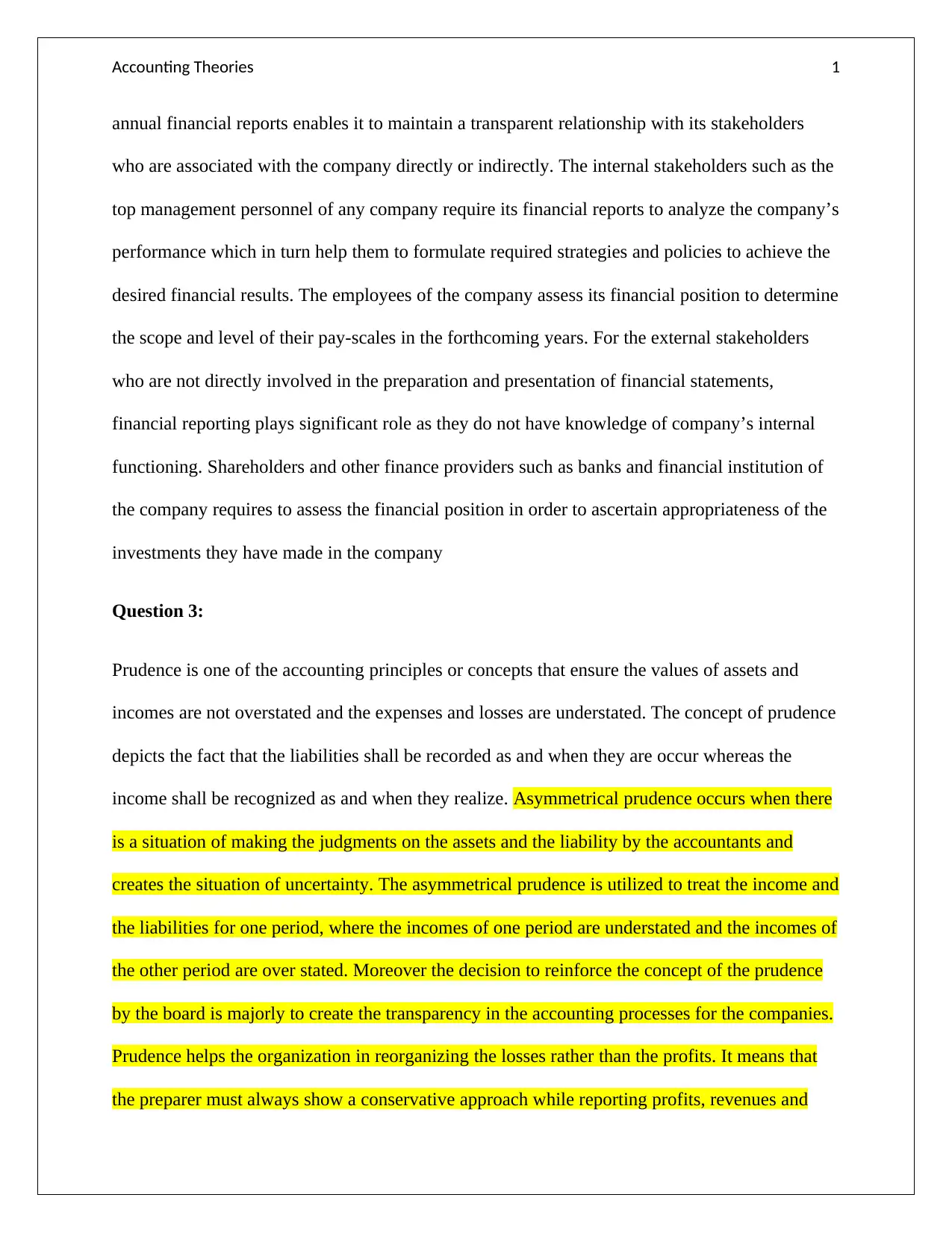
Accounting Theories 1
annual financial reports enables it to maintain a transparent relationship with its stakeholders
who are associated with the company directly or indirectly. The internal stakeholders such as the
top management personnel of any company require its financial reports to analyze the company’s
performance which in turn help them to formulate required strategies and policies to achieve the
desired financial results. The employees of the company assess its financial position to determine
the scope and level of their pay-scales in the forthcoming years. For the external stakeholders
who are not directly involved in the preparation and presentation of financial statements,
financial reporting plays significant role as they do not have knowledge of company’s internal
functioning. Shareholders and other finance providers such as banks and financial institution of
the company requires to assess the financial position in order to ascertain appropriateness of the
investments they have made in the company
Question 3:
Prudence is one of the accounting principles or concepts that ensure the values of assets and
incomes are not overstated and the expenses and losses are understated. The concept of prudence
depicts the fact that the liabilities shall be recorded as and when they are occur whereas the
income shall be recognized as and when they realize. Asymmetrical prudence occurs when there
is a situation of making the judgments on the assets and the liability by the accountants and
creates the situation of uncertainty. The asymmetrical prudence is utilized to treat the income and
the liabilities for one period, where the incomes of one period are understated and the incomes of
the other period are over stated. Moreover the decision to reinforce the concept of the prudence
by the board is majorly to create the transparency in the accounting processes for the companies.
Prudence helps the organization in reorganizing the losses rather than the profits. It means that
the preparer must always show a conservative approach while reporting profits, revenues and
annual financial reports enables it to maintain a transparent relationship with its stakeholders
who are associated with the company directly or indirectly. The internal stakeholders such as the
top management personnel of any company require its financial reports to analyze the company’s
performance which in turn help them to formulate required strategies and policies to achieve the
desired financial results. The employees of the company assess its financial position to determine
the scope and level of their pay-scales in the forthcoming years. For the external stakeholders
who are not directly involved in the preparation and presentation of financial statements,
financial reporting plays significant role as they do not have knowledge of company’s internal
functioning. Shareholders and other finance providers such as banks and financial institution of
the company requires to assess the financial position in order to ascertain appropriateness of the
investments they have made in the company
Question 3:
Prudence is one of the accounting principles or concepts that ensure the values of assets and
incomes are not overstated and the expenses and losses are understated. The concept of prudence
depicts the fact that the liabilities shall be recorded as and when they are occur whereas the
income shall be recognized as and when they realize. Asymmetrical prudence occurs when there
is a situation of making the judgments on the assets and the liability by the accountants and
creates the situation of uncertainty. The asymmetrical prudence is utilized to treat the income and
the liabilities for one period, where the incomes of one period are understated and the incomes of
the other period are over stated. Moreover the decision to reinforce the concept of the prudence
by the board is majorly to create the transparency in the accounting processes for the companies.
Prudence helps the organization in reorganizing the losses rather than the profits. It means that
the preparer must always show a conservative approach while reporting profits, revenues and
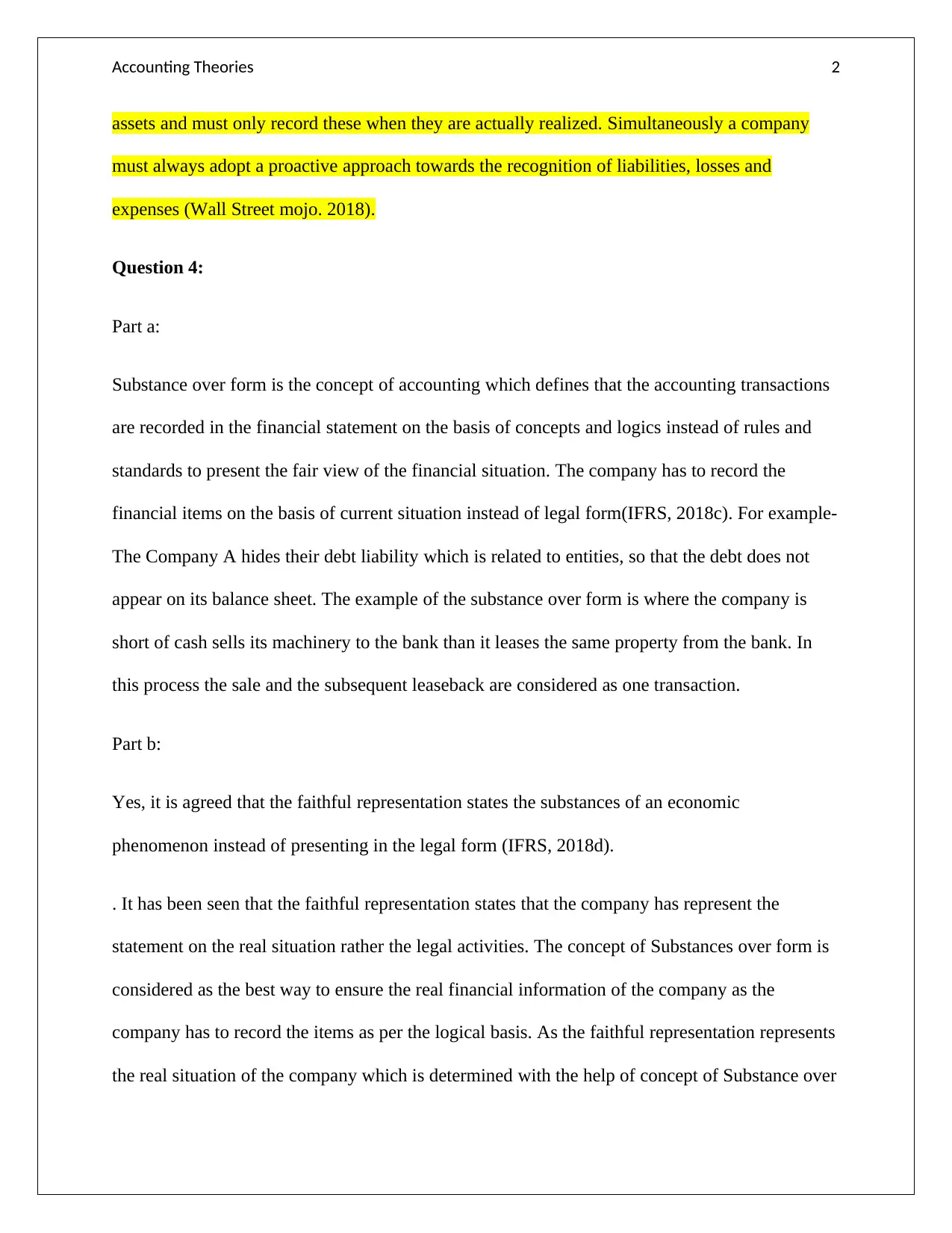
Accounting Theories 2
assets and must only record these when they are actually realized. Simultaneously a company
must always adopt a proactive approach towards the recognition of liabilities, losses and
expenses (Wall Street mojo. 2018).
Question 4:
Part a:
Substance over form is the concept of accounting which defines that the accounting transactions
are recorded in the financial statement on the basis of concepts and logics instead of rules and
standards to present the fair view of the financial situation. The company has to record the
financial items on the basis of current situation instead of legal form(IFRS, 2018c). For example-
The Company A hides their debt liability which is related to entities, so that the debt does not
appear on its balance sheet. The example of the substance over form is where the company is
short of cash sells its machinery to the bank than it leases the same property from the bank. In
this process the sale and the subsequent leaseback are considered as one transaction.
Part b:
Yes, it is agreed that the faithful representation states the substances of an economic
phenomenon instead of presenting in the legal form (IFRS, 2018d).
. It has been seen that the faithful representation states that the company has represent the
statement on the real situation rather the legal activities. The concept of Substances over form is
considered as the best way to ensure the real financial information of the company as the
company has to record the items as per the logical basis. As the faithful representation represents
the real situation of the company which is determined with the help of concept of Substance over
assets and must only record these when they are actually realized. Simultaneously a company
must always adopt a proactive approach towards the recognition of liabilities, losses and
expenses (Wall Street mojo. 2018).
Question 4:
Part a:
Substance over form is the concept of accounting which defines that the accounting transactions
are recorded in the financial statement on the basis of concepts and logics instead of rules and
standards to present the fair view of the financial situation. The company has to record the
financial items on the basis of current situation instead of legal form(IFRS, 2018c). For example-
The Company A hides their debt liability which is related to entities, so that the debt does not
appear on its balance sheet. The example of the substance over form is where the company is
short of cash sells its machinery to the bank than it leases the same property from the bank. In
this process the sale and the subsequent leaseback are considered as one transaction.
Part b:
Yes, it is agreed that the faithful representation states the substances of an economic
phenomenon instead of presenting in the legal form (IFRS, 2018d).
. It has been seen that the faithful representation states that the company has represent the
statement on the real situation rather the legal activities. The concept of Substances over form is
considered as the best way to ensure the real financial information of the company as the
company has to record the items as per the logical basis. As the faithful representation represents
the real situation of the company which is determined with the help of concept of Substance over
⊘ This is a preview!⊘
Do you want full access?
Subscribe today to unlock all pages.

Trusted by 1+ million students worldwide
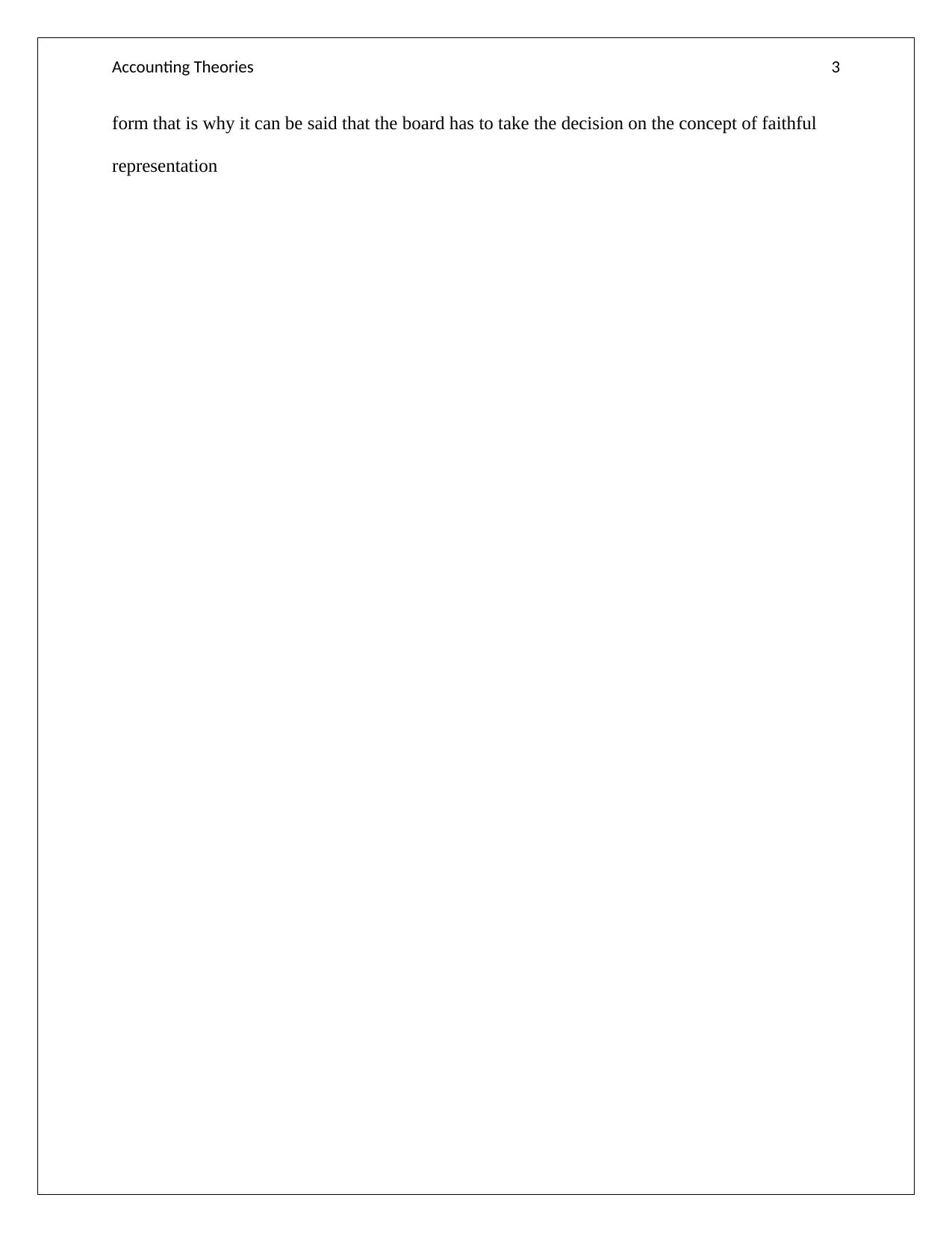
Accounting Theories 3
form that is why it can be said that the board has to take the decision on the concept of faithful
representation
form that is why it can be said that the board has to take the decision on the concept of faithful
representation
Paraphrase This Document
Need a fresh take? Get an instant paraphrase of this document with our AI Paraphraser
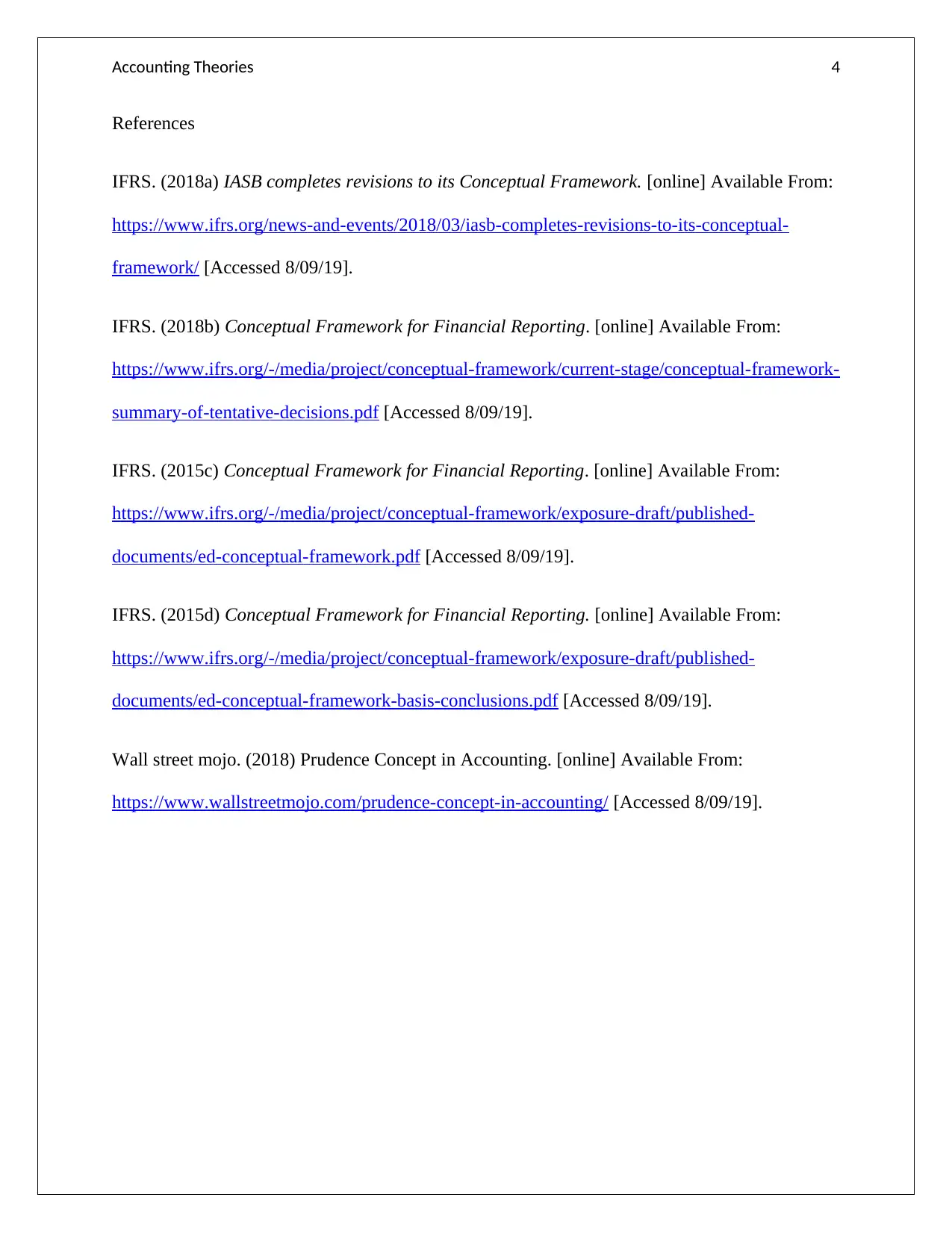
Accounting Theories 4
References
IFRS. (2018a) IASB completes revisions to its Conceptual Framework. [online] Available From:
https://www.ifrs.org/news-and-events/2018/03/iasb-completes-revisions-to-its-conceptual-
framework/ [Accessed 8/09/19].
IFRS. (2018b) Conceptual Framework for Financial Reporting. [online] Available From:
https://www.ifrs.org/-/media/project/conceptual-framework/current-stage/conceptual-framework-
summary-of-tentative-decisions.pdf [Accessed 8/09/19].
IFRS. (2015c) Conceptual Framework for Financial Reporting. [online] Available From:
https://www.ifrs.org/-/media/project/conceptual-framework/exposure-draft/published-
documents/ed-conceptual-framework.pdf [Accessed 8/09/19].
IFRS. (2015d) Conceptual Framework for Financial Reporting. [online] Available From:
https://www.ifrs.org/-/media/project/conceptual-framework/exposure-draft/published-
documents/ed-conceptual-framework-basis-conclusions.pdf [Accessed 8/09/19].
Wall street mojo. (2018) Prudence Concept in Accounting. [online] Available From:
https://www.wallstreetmojo.com/prudence-concept-in-accounting/ [Accessed 8/09/19].
References
IFRS. (2018a) IASB completes revisions to its Conceptual Framework. [online] Available From:
https://www.ifrs.org/news-and-events/2018/03/iasb-completes-revisions-to-its-conceptual-
framework/ [Accessed 8/09/19].
IFRS. (2018b) Conceptual Framework for Financial Reporting. [online] Available From:
https://www.ifrs.org/-/media/project/conceptual-framework/current-stage/conceptual-framework-
summary-of-tentative-decisions.pdf [Accessed 8/09/19].
IFRS. (2015c) Conceptual Framework for Financial Reporting. [online] Available From:
https://www.ifrs.org/-/media/project/conceptual-framework/exposure-draft/published-
documents/ed-conceptual-framework.pdf [Accessed 8/09/19].
IFRS. (2015d) Conceptual Framework for Financial Reporting. [online] Available From:
https://www.ifrs.org/-/media/project/conceptual-framework/exposure-draft/published-
documents/ed-conceptual-framework-basis-conclusions.pdf [Accessed 8/09/19].
Wall street mojo. (2018) Prudence Concept in Accounting. [online] Available From:
https://www.wallstreetmojo.com/prudence-concept-in-accounting/ [Accessed 8/09/19].
1 out of 5
Related Documents
Your All-in-One AI-Powered Toolkit for Academic Success.
+13062052269
info@desklib.com
Available 24*7 on WhatsApp / Email
![[object Object]](/_next/static/media/star-bottom.7253800d.svg)
Unlock your academic potential
Copyright © 2020–2025 A2Z Services. All Rights Reserved. Developed and managed by ZUCOL.





